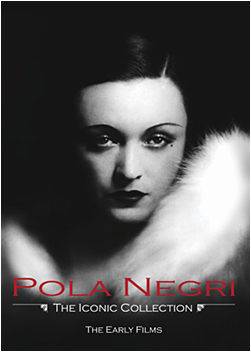
Pola Negri, The Iconic Collection: The Early Films
A Review by David Gasten
 |
Pola Negri, The Iconic Collection: The Early Films. NTSC Region 0 (all region) 3-DVD set. Featuring the films The Polish Dancer (1917), The Yellow Ticket (1918), The Eyes of the Mummy Ma (1918), and Sappho (1921). Released by Bright Shining City Productions, 2011. $39.99 plus shipping; ships worldwide.
Click to buy Pola Negri, The Iconic Collection: The Early Films from Bright Shining City Productions.
In the last decade, we’ve been blessed with a cavalcade of home video editions of Pola Negri’s films, official and bootleg, that have allowed us to see for ourselves what a great actress Pola Negri was. This new availability of Pola's movies has done much to silence the old wives' tales that encroached upon Pola's reputation previously. Mariusz Kotowski, owner of film production company Bright Shining City Productions and director of the documentary Pola Negri: Life is a Dream in Cinema (2006), has taken this to the next level with the release of Pola Negri, The Iconic Collection: The Early Films (2011), a lovingly packaged 3-DVD set featuring four of Pola Negri’s early movies, two of which receive a home video release here for the first time ever. With the inclusion of rare photos and some minimalistic short subjects that showcase Pola as a stunning personality and a lovely singer, the set makes a great beginner’s introduction to Pola Negri, as well as a revelation for longtime Pola fans.
Part 1: The Movies
Pola Negri, The Iconic Collection features four Pola Negri films spanning the Polish and German silent portions of her career. The movies are as follows:
The Polish Dancer (aka Bestia, 1917)
The Yellow Ticket ( aka Der Gelbe Schein, 1918)
The Eyes of the Mummy Ma (aka The Eyes of the Mummy, 1918)
Sappho (1921)
Trailer for the Pola Negri, The Iconic Collection: The Early Films (2011) 3-DVD set. |
All of these movies feature new English-language intertitles and piano scores by composer Rick De Jonge. At times these scores could do better at following the moods and there are a couple of fade transitions that are a little too noticeable, but there are many other times that it does a fantastic job of supporting the movie and helping to get the correct moods across without ever overshadowing the movie.
The Polish Dancer (1917) is the true gem in this collection. The film is one of only a few of Pola Negri’s Polish-period silents that still survive, and this is the first time it has EVER been available for viewing outside of a film museum or the rare retrospective screening.
The Polish Dancer stands as an enjoyable movie with an overall good storyline. One of the intertitles states, “Pola is having too much fun,” and it looks like that’s exactly what happened in this picture: she had a ball on screen and got paid to do it. Pola is adorable, feisty, flirtatious, kitten-like, tempestuous, passionate and outrageously sexy in this picture, putting in one her most adorable, burn-a-hole-in-the-screen performances this side of the restored Sumurun (1920). It’s interesting to see her on-screen personality so well-developed this early on in her career.
It is through watching the film and through some newly-available information dug up recently that we are able to discern that this film is not Niewolnica Zmysłóv, Poland’s first ever feature film and Pola Negri’s film debut, but rather Bestia, which was filmed in 1916 and apparently made its screening debut on January 5, 1917. This leaves Niewolnica Zmysłóv as a lost film. What in particular gives away that this is Bestia is the lengthy dance performance from Mia Mara, another popular theatre actress from Poland who was apparently even better-known that Pola Negri at the time (Mara is given top billing in a newspaper ad for Bestia from a vintage Polish newspaper). Mara went on to act in many German silent films (including 1925’s The Joyless Street) under the name Lya Mara. This is the only appearance that she makes in any of Pola’s silent films, and it appears that her cameo is added as a guest star attraction to sell tickets. Rick DeJonge’s piano score is at its very best here as it follows Mara’s adorable, fairy-like nymph dance routine.
The Yellow Ticket (1918) was a German remake of Pola’s Polish film Czarna Książeczka, which is now a lost film. Because of the film’s sympathy toward Jews living in anti-Semitic conditions in Russia, the Nazis allegedly attempted to destroy the film during the WWII era, but it survived nonetheless and fortunately is still with us today. Kevin Brownlow restored this rare film number of years ago, but it has never been released on home video until now.
The Yellow Ticket is in the worst physical condition of all of the films in the set, with many specks and blemishes in the film’s source print, but it’s an enjoyable movie with a great dramatic storyline that involves heartbreak, melodrama with surprise connections amongst the main players, and a positive message about embracing humanity over race, a common thread in the lichtspiel films that were being made and shown in Germany at the time. Pola plays a double role, as both the main character Lea, and as her mother who dies tragically, so Pola gets to be two tragediennes in one movie. This version apparently grayscales the tints and tones of the Kevin Brownlow restoration out, but it’s still nice to have the film available at last.
Discs 2 and 3 feature the Pola films The Eyes of the Mummy (1918, shown here as The Eyes of the Mummy Ma) and Sappho (1921) respectively. The Eyes of the Mummy has seen several releases in the past decade that all pull from the exact same source material, and unfortunately this edition does not add anything new to previous editions; Grapevine Video’s edition of The Eyes of the Mummy is still the best quality version.
In Sappho, the intertitiles are slightly improved and help tell the story slightly better than do the original intertitles. The lone surviving print of Sappho is tinted and toned throughout and also contains English intertitles with some stunted translation from the original German. This version actually improves the translation of a number of the intertitles with smoother English, which is a plus. With the film being grayscaled to black and white, it allows one to see some more detail in the picture that the tints tend to obscure because they are so illuminating to the picture. So it offers an alternate way to experience Sappho, but does not replace the release of Sappho in Grapevine Video’s Ladies of the German Cinema DVD, which does include the original tints and intertitles along with a devastating orchestral score that really drives home the movie’s tragic story and brutal ending.
Part 2: The Packaging and Extras
One of DVD producer Mariusz Kotowski’s goals with not only The Iconic Collection, but all his work in preserving Pola Negri’s legacy, is to present Pola in a way that connects with current movie fans. He has accomplished this in no uncertain terms with the lovely, classy packaging of this box set, one that exudes class, but also invites the movie fan to fall in love with Pola. Kotowski presents Pola as an actress that is as entertaining and lovable today as she was in the 1910’s and 1920’s.
Trailer for the Pola Negri: Life is a Dream in Cinema (2006) documentary, included in The iconic Collection as an bonus feature. |
The DVD extras are as follows:
• A trailer for the Pola Negri: Life is a Dream in Cinema (2006) documentary, which is in and of itself a minimalistic masterpiece. It segues together three of Pola’s on-screen film appearances with clips of Pola’s acting and some minimalistic that speaks for itself; it has to be seen to be fully appreciated.
• A modern tango dance sequence set to Pola’s recorded version of Tango Notturno, which has the problem of having to stretch the sequence to fill the full song, but does a decent job of doing that.
• A small photo gallery of some of Pola’s cutest and most stunning photos, including a couple taken by classic Hollywood photographer Eugene Richee. Many of them were also published in Kotowski’s Polish-language Negri biography Pola Negri: Legenda Hollywood (2011).
• A trailer for the Pola Negri, the Iconic collection: The Early Films set.
• A Pola Negri bio.
The menus are easy to navigate and very sleek and modern-looking, but also have an air of mystery to them that fits Pola’s screen persona very well.
This edition of the three-DVD set is a small-run edition with professionally-printed DVD-R’s housed in a conventional multi-disc DVD case with an eight-page booklet. The booklet features another short Pola Negri bio, with summaries and credits for all four on the movies dispersed amongst well-selected still photos of Pola. There are some factual errors and stunted writing, but it still looks nice; the errors could always be corrected in future editions of the set.
Overall, The Iconic Collection is Pola’s best and most voluminous home video release yet, one that demonstrates Pola to be the lovable, classy, sensuous, and outrageously talented icon that she is. This was a very needed release, and its debuting of The Polish Dancer and The Yellow Ticket on home video is an event in and of itself for Pola Negri fans. Congrats to Bright Shining City Productions on this fantastic release!

